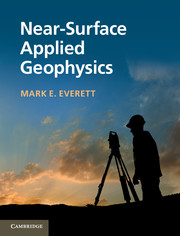Book contents
- Frontmatter
- Contents
- Preface
- Acknowledgments
- 1 Introduction
- 2 Data analysis
- 3 Magnetics
- 4 Electrical resistivity method
- 5 Induced polarization and self-potential
- 6 Seismic reflection and refraction
- 7 Seismic surface-wave analysis
- 8 Electromagnetic induction
- 9 Ground-penetrating radar
- 10 Emerging techniques
- 11 Linear inversion
- 12 Non-linear inversion: local methods
- 13 Non-linear inversion: global methods
- Appendix A Shannon sampling theorem
- Appendix B Solution of Laplace’s equation in spherical coordinates
- Appendix C The linear τ–p transformation of seismic data
- Appendix D Horizontal loop over a conducting halfspace
- Appendix E Radar TE waveguide mode equations
- References
- Index
- Plate section
9 - Ground-penetrating radar
Published online by Cambridge University Press: 05 April 2013
- Frontmatter
- Contents
- Preface
- Acknowledgments
- 1 Introduction
- 2 Data analysis
- 3 Magnetics
- 4 Electrical resistivity method
- 5 Induced polarization and self-potential
- 6 Seismic reflection and refraction
- 7 Seismic surface-wave analysis
- 8 Electromagnetic induction
- 9 Ground-penetrating radar
- 10 Emerging techniques
- 11 Linear inversion
- 12 Non-linear inversion: local methods
- 13 Non-linear inversion: global methods
- Appendix A Shannon sampling theorem
- Appendix B Solution of Laplace’s equation in spherical coordinates
- Appendix C The linear τ–p transformation of seismic data
- Appendix D Horizontal loop over a conducting halfspace
- Appendix E Radar TE waveguide mode equations
- References
- Index
- Plate section
Summary
While seismic-reflection and -refraction techniques are commonly employed to map near-surface layers, they do not have the high vertical resolution (detection of subsurface structures with length scales of 1.0 m or less) that is required for many applications. Ground-penetrating radar (GPR) can be a suitable geophysical tool in these situations. The technique is used to detect changes in subsurface electromagnetic impedance via the propagation and reflection at impedance boundaries of an electromagnetic wave generated by a transmitter deployed at the surface or, less commonly, within a borehole. Typical GPR frequencies are in the 10 MHz to 1 GHz range, much higher than the frequencies used in the electromagnetic (EM) induction method (see Chapter 8). The popularity of GPR as a near-surface geophysical technique lies partially in the similar appearance of radar sections to the seismic sections that are familiar to many geophysicists (Figure 9.1). Both seismic reflection and GPR are imaging techniques based on wave-propagation principles but there are important differences; these will be discussed in this chapter. Good overviews of the theory and practice of GPR appear in Davis and Annan (1989), Knight (2001), Neal (2004), Annan (2009), and Conyers (2011).
Example. Perchlorate transport in karst.
The occurrence of the perchlorate ion ClO4− in groundwater presents a great risk to human health since perchlorate has long been known to inhibit proper functioning of the thyroid. Beneath the Naval Weapons Industrial Reserve Plant (NWIRP) in central Texas, significant concentrations of perchlorate ions derived from the manufacture of rocket propellant have been detected in groundwater and springs. Hughes (2009) has described a wide-area (~ 500 ha) GPR survey in karst terrain with the goal of mapping subsurface structural features that might be indicative of major pathways for subsurface transport of perchlorate ions. The survey was executed by towing a 50 MHz GPR system for ~ 100 line-km on a sled behind an all-terrain vehicle.
- Type
- Chapter
- Information
- Near-Surface Applied Geophysics , pp. 239 - 278Publisher: Cambridge University PressPrint publication year: 2013
- 2
- Cited by



